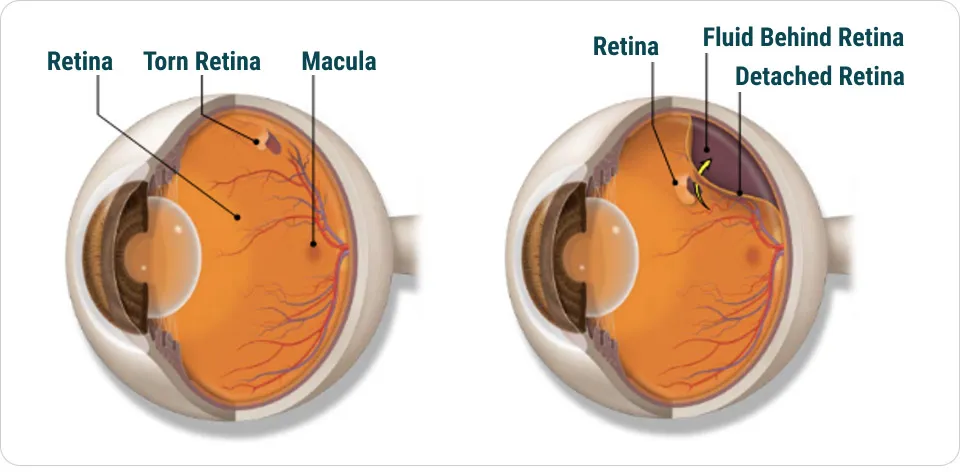Retinal Evaluations

What are common retinal problems?
Torn Retina and Causes
A torn retina is a serious problem that makes your vision blurry. It is when the retina has a tear or hole, like a rip in cloth. A torn retina often leads to a more serious condition called a detached retina. This is where the retina is lifted away from the back of the eye. A torn retina must be treated right away to avoid further vision
problems.
As we get older, the vitreous in our eyes starts to shrink and get thinner. Usually the vitreous moves around on the retina without causing problems. But the vitreous may stick to the retina and pull hard enough to tear it. When the retina tears, you may suddenly see flashes of light or floaters. Sometimes blood can leak into the vitreous. This is called a vitreous hemorrhage, and it can cause a large number of floaters.
Detached Retina and Causes
A detached retina is when the retina lifts away from the back of the eye. The retina does not work when it is detached, making vision blurry. A detached retina is a serious problem. An ophthalmologist needs to check it
out right away, or you could lose sight in that eye.
As we age, the vitreous in our eyes starts to shrink and get thinner. As the eye moves, the vitreous moves around on the retina without causing problems. But sometimes the vitreous may stick to the retina and pull hard enough to tear it. When that happens, fluid can pass through the tear and lift (detach) the retina.

Retinal Tear Treatment Options
There are two ways your eye surgeon may fix your retinal tear:
Photocoagulation
A laser is used to seal the retina to the wall of the eye. The goal is to keep fluid from going through the tear and detaching the retina.
Cryopexy
Extreme cold is used to seal the retina to the wall of the eye. The goal is to keep fluid from going through the tear and detaching the retina.
Detached Retina Treatment Options
Surgery is done to repair a detached retina. Here are some types of detached retina surgery:
Pneumatic Retinopexy
Your ophthalmologist puts a gas bubble inside your eye. This pushes the retina into place so it can heal properly. Afterwards, you will need to keep your head in a very specific position as your doctor recommends for a few days. This keeps the bubble in the right place. As your eye heals, your body makes fluid that fills the eye. Over time, this fluid replaces the gas bubble.
Vitrectomy
Your ophthalmologist removes the vitreous pulling on the retina. The vitreous will be replaced with an air, gas, or oil bubble. The bubble pushes the retina into place so it can heal properly. If an oil bubble is used, your ophthalmologist will remove it a few months later. With an air or gas bubble, you cannot fly in an airplane or travel to high altitudes or scuba dive. This is because altitude change causes the gas to expand, increasing eye pressure.
Scleral Buckle
A band of rubber or soft plastic is sewn to the outside of your eyeball. It gently presses the eye inward. This helps the detached retina heal against the eye wall. You will not see the scleral buckle on the eye. It is usually left on the eye permanently.
